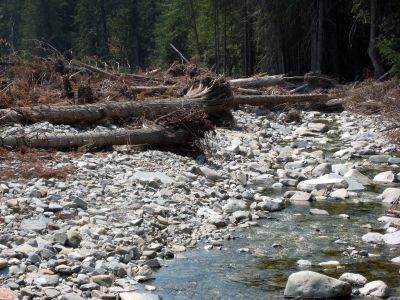Some roads to stay closed
Agency plans to fix Lightning Creek route

After winter storms dropped 20 inches of snow and rain in the Lightning Creek drainage in late 2006, flooding devoured millions of dollars worth of backcountry roads.
The roads provided access to popular recreation spots near Sandpoint for huckleberry picking, hunting, hiking, and horseback and ATV riding. But given the area’s history of blowout floods, the Forest Service plans to reopen only a portion of the roads.
Lightning Creek is the wettest drainage in Idaho, with an average precipitation of 94 inches annually. Every five or six years, a major flood sweeps away roads and bridges, said Dick Kramer, the Sandpoint District ranger.
“It doesn’t make sense for us to keep fixing it,” he said.
The Forest Service is proposing to rebuild the main road through the Lightning Creek drainage, while permanently closing miles of side roads. Some could still be accessed by motorcycles, bicycles or foot traffic.
Driving a pickup over rutted roads to Porcupine Lake, for instance, would no longer be an option, though people could still make the trip by motorcycle or ATV. Reaching a rock pit where members of the public can get permits to collect flagstones would require a driving detour through Montana.
Kramer said the plan balances the public’s desire for motorized access with fiscal realities.
The Forest Service’s Northern Region has a $730 million backlog of road maintenance. On the Idaho Panhandle National Forests, road funding dropped 26 percent in the past four years.
The Forest Service applied for $2.5 million from the Federal Highway Administration to help cover the cost of reconstructing Lightning Creek’s roads. Like his agency, the highway administration isn’t interested in paying for roads prone to future flood damage, Kramer said.
Protecting grizzlies and bull trout was also part of the Forest Service’s deliberation, Kramer said. Grizzlies live in the forest surrounding Lightning Creek, and the bears tend to avoid areas with traffic.
After the floods, Brad Smith of the Idaho Conservation League hiked 40 miles though the Lightning Creek drainage. With the roads impassable, wildlife was easier to spot, he said. Smith saw his first bobcat in the wild, and he and a fellow hiker also found wolf scat.
“The public will still be able to get back into many of these areas,” said Smith, who supports the plan for reduced vehicle use.
John Finney, a Sandpoint attorney, frequently recreates in the Lightning Creek drainage. He’s a member of Sandpoint Winter Riders snowmobile club, and also hikes and rides ATVs.
Some people will miss driving to Porcupine Lake, which was one of the few alpine lakes in the forest that people could reach by passenger vehicle, Finney said. The Rattle Creek Road was also a popular route for scenic drives and huckleberry picking, he said.
The Forest Service isn’t planning to reconstruct the road, but Finney hopes the agency might consider repairing the road to allow ATV traffic.
Kramer expects to finalize the Lighting Creek road plan by February. Road repair could begin next summer, with the work taking three to five years to complete, he said.